|
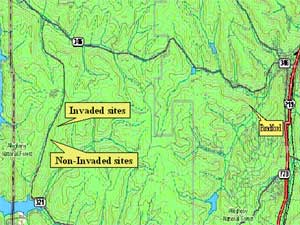
Since the summer of 1999, we have been investigating the
impact of the invasive hay-scented fern, Dennstaedtia punctibobula,
and of various environmental conditions on salamander populations
in the Allegheny National Forest in McKean County, PA. Eight
established 8 X 8 meter plots are being evaluated: 2 non-invaded
(no hay-scented fern) terrestrial plots; 2 invaded (with hay-scented
fern) terrestrial plots; 2 aquatic non-invaded plots, and
2 aquatic invaded plots. In addition 4 random plots are established
each summer: 1 non-invaded terrestrial, 1 invaded terrestrial,
1 non-invaded aquatic, and one invaded aquatic. All terrestrial
plots have similar topography and all aquatic plots have similar
topography.

Four sets of sixteen 6 X 8 X 1 inch untreated, pine shelving
boards were placed flush with the ground under the leaf litter
in each plot and the duff replaced over the boards. The leaf
litter covering the boards and the area under each board was
examined for salamanders each sampling period. Salamanders
were collected, tallied, identified, snout to vent length
measured, and gravid females noted. The salamanders and litter
were then replaced as found.
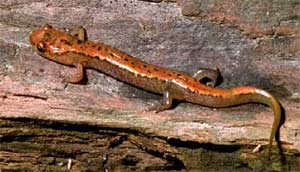
Various physical parameters were measured: water and soil
pH; % moisture of both litter and soil; % canopy cover; air,
soil, and water temperature; and relative humidity.
The number of hay-scented fern fronds in each plot was counted
and recorded. In addition an inventory of the plants in each
plot was done.
The salamander species found thus far are: Mountain Dusky,
Red Back, Slimy, Wehrle's, Spring, and Northern Dusky.
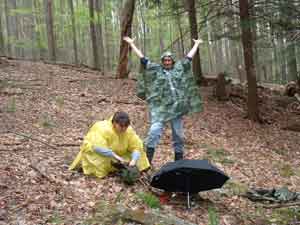
Summer 2002:
We concluded the four-year monitoring study in August
2002. We are currently in the process of analyzing all the
data collected and preparing a manuscript for journal submission.
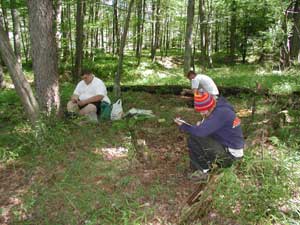
Undergraduate Student Researchers:
Samuel Cercone, Biology major
Allison Charney, Geology & Environmental Science major
Kris Dominy, Geology & Environmental Science major
Hope Dotter, Biology major
Tracy Guenther
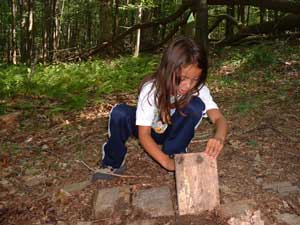
Summer 2001:
A three-year summary of the relationship between an invasive
fern and salamander populations in the Allegheny National
Forest
by Gretchen Sterba*, Hope Dotter*, John Skinner, Dessie Severson,
and Thomas Pauley, Allegheny Institute of Natural History,
University of Pittsburgh - Bradford, Bradford, PA 16701
We investigated the impact of the invasive hay-scented fern,
Dennstaedtia punctibobula, and selective environmental conditions
on salamander populations in the Allegheny National Forest
in McKean County, PA. Eight plots were evaluated: 2 terrestrial
non-invaded, 2 terrestrial invaded, 2 aquatic non-invaded,
and 2 aquatic invaded. In both aquatic and terrestrial plots,
the soil was more acidic in the invaded than in the non-invaded
plots. For the terrestrial plots a positive correlation was
found between the number of Desmognathus ochrophaeus, mountain
dusky salamanders, and soil pH. The mountain dusky salamander
was the most abundant salamander. The terrestrial invaded
sites had significantly fewer salamanders than did the non-invaded
sites. Although further experiments are needed to assign cause
and effect, the results of this three-year study suggest that
salamanders are sensitive to conditions characterizing habitats
invaded by the hay-scented fern.

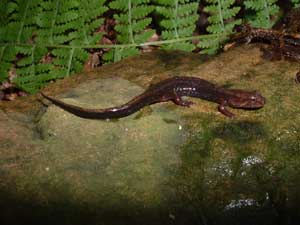
Undergraduate Student Researchers:
Hope Dotter, Biology major
Tracy Guenther, Biology major
John Skinner, Biology major
Gretchen Sterba, Biology major
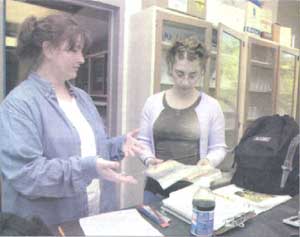
Summer 2000:
An Investigation of the Relationship Between Invasive
Plants and Salamander Populations in the Allegheny National
Forest.
by Tracy Guenther*, Star Dunham, Dessie Severson, and Thomas
Pauley, Allegheny Institute of Natural History, University
of Pittsburgh at Bradford, Bradford, PA 16701
We investigated the impact of the invasive fern Dennstaedtia
punctibobula and selective environmental conditions on salamander
populations in the Allegheny National Forest in McKean County,
PA. Eight plots were evaluated: 2 terrestrial non-invaded
( = 6.0 fronds/plot), 2 terrestrial invaded ( = 409.00 fronds/plot),
2 aquatic non-invaded ( = 20.0 fronds/plot), and 2 aquatic
invaded ( = 208.66 fronds/plot). In aquatic and terrestrial
plots, the soil was more acidic in the invaded than in the
non-invaded plots (compared with t-tests, p<0.05, df=18
for both). For the terrestrial plots a positive correlation
was found between the number of mountain dusky salamanders
and soil pH (r=0.501, p< 0.03, n= 21), but soil pH was
negatively correlated with the number of redback salamanders
(r=-0.503, p<0.03, n=21). Although further experiments
are needed to assign cause and effect, these results suggest
that salamanders are sensitive to conditions characterizing
habitats invaded by the fern.
Undergraduate Student Researchers:
Star Dunham, Biology major
Tracy Guenther, Biology major
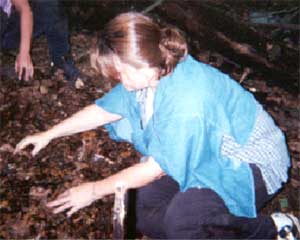
Summer 1999:
Salamander populations in the Allegheny National Forest:
the role of bryophytes.
by Tracy Guenther and Dessie Severson, Allegheny Institute
of Natural History, University of Pittsburgh at Bradford,
Bradford, PA 16701
Invasive plants influence biotic diversity. Management practices
in the Alleghenies have created conditions for the spread
of Dennstaedtia punctilobula (hay-scented fern.) We investigated
the impact of D. punctilobula on bryophyte and salamander
populations in the Allegheny National Forest in McKean County,
PA. Four sites were compared: one terrestrial and one seep
with an average of 1.1 hay-scented fern fronds per meter squared
and one terrestrial and one seep with no invasive ferns. Both
seep sites had more spatial heterogeneity and greater bryophyte
and salamander diversity than the terrestrial sites. The invasive-fern
sites had an average soil pH of 3.91 and one third fewer Desmognathus
ochrophaeus (mountain dusky salamander) and fewer bryophytes
than the no-invasive-fern sites, with an average soil pH of
4.78 (t=3.44, df=18, p<0.05). The terrestrial-invasive-fern
site had 34 bryophyte censuses, with none on bare soil, compared
to 43 censuses, with 6 on soil, in the fern-free site.
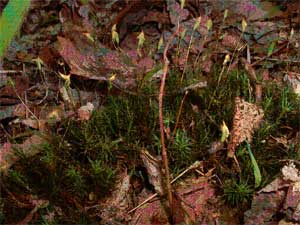
Salamander populations in the Allegheny National Forest:
the role of invasive plants.
by Eileen Burley, Mariah Peterman, Lisa Van Gorden, Dessie
Severson, and Thomas Pauley, Allegheny Institute of Natural
History, University of Pittsburgh at Bradford, Bradford, PA
16701
Invasive plant species can influence plant and animal diversity.
Timber and wildlife management practices in the Allegheny
hardwood forest have created conditions for the spread of
the hayscented fern (Dennstaedtia punctilobula). We investigated
the impact of D. punctilobula on salamander populations in
the Allegheny National Forest in McKean County, PA. Two sites,
each surrounding a seep with standing water, were compared;
one site had no hayscented ferns and few other fern species,
and the second site averaged approximately 1.1 hayscented
fern fronds per meter squared. The soil pH at the site with
high fern density was lower than at the low fern density site
(t=3.44, df=18, p<0.05). The mountain dusky salamander
(Desmognathus ochrophaeus) was the most abundant salamander,
but the terrestrial site with more ferns had only one third
as many individuals as the site lacking ferns (X^2>10;
df=1, P< 0.001).
Undergraduate Student Researchers:
Eileen Burley, Biology major
Tracy Guenther, Biology major
Mariah Peterman, Biology major
Lisa Van Gorden, Biology major
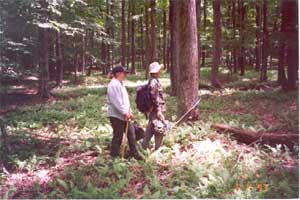
|

